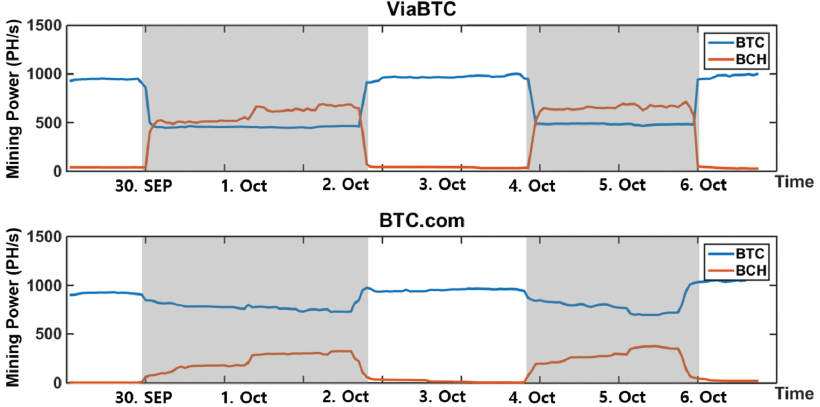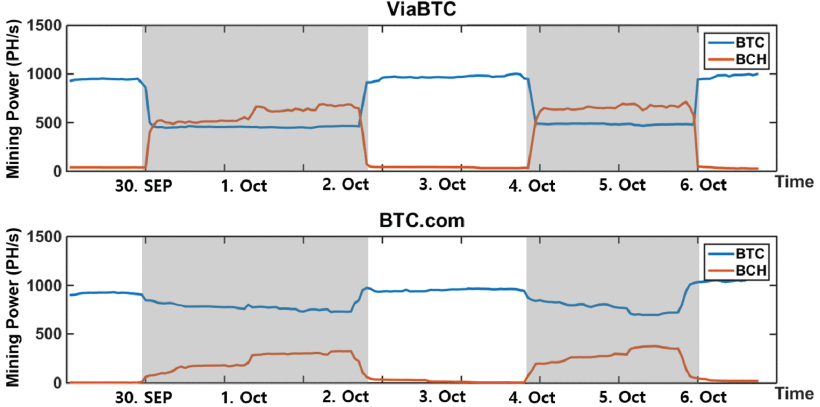Before Nov. 13, 2017, BCH adjusted the mining difficulty every 2016 block to ensure that the average time period for generating a block is 10 minutes, like in the case of BTC. In doing so, if the time required for generating past 2016 blocks is longer than two weeks, the mining difficulty decreases, and miners can generate subsequent blocks more easily. In addition, BCH added a new difficulty adjustment algorithm called emergency difficulty adjustment (EDA) [7] to decrease the mining difficulty without waiting for 2016 blocks to be generated when it is significantly difficult to find a valid block.
Because BTC and BCH have a PoW mechanism compatible with each other, miners can freely switch between them depending on the mining difficulty and the coin price. However, because the change in coin price is hard to predict, some miners immediately change their coin only when mining difficulty changes, where we call this behavior fickle mining. Concretely, the fickle miners first conduct BTC mining, observing the changes in the mining difficulties of BTC and BCH. Then, if the BCH mining difficulty is low, they immediately shift to BCH mining. When the BCH mining difficulty increases again thanks to its difficulty adjustment algorithm, fickle miners immediately shift to BTC mining. Fickle mining can boost the profits of miners; however, this behavior might cause instability of both BTC and BCH.
This mining behavior was easily observed in Bitcoin when we monitored the mining power in pools. We collected mining power history data over the course of a week from two popular pools: ViaBTC [8] and BTC.com [9]. These two pools support both BTC and BCH mining; miners in the pools can choose either BTC or BCH mining by just clicking one button. Figure 1 represents the mining power data of ViaBTC and BTC.com for a week. In the figure, the grey regions show movements of mining power from BTC to BCH mining.

Mining power history of ViaBTC and BTC.com (Sep. 29, 2017 ∼ Oct. 6, 2017). The grey regions represent movements of mining power from BTC to BCH.

Mining power history of ViaBTC (Dec. 5, 2017 ∼ Dec. 8, 2017). Grey regions represent movements of mining power from BTC to BCH. Note that we only displayed the mining power history of ViaBTC because BTC.com did not evidently execute fickle mining for this period.
As fickle mining causes a sudden increase in mining power as shown in the grey zones of Figure 1, many blocks were generated quite quickly in the BCH system. For example, in the BCH system, 2016 blocks were generated within only three days in each grey zone. This caused the blockchain of BCH to be thousands of blocks ahead of BTC, and the halving time of the block reward in BCH was brought forward. To address this issue, BCH performed another hard fork on Nov. 13, 2017 [10]. Currently, BCH adjusts the difficulty for each block based on the previous 144 blocks as a moving window [11]. To determine if it is possible that miners conduct fickle mining even after the hard fork of Nov. 13, 2017, we investigated the BCH mining power data of ViaBTC for four days (Dec. 5, 2017, ∼ Dec. 8, 2017). Figure 2 represents the BCH mining power data of ViaBTC during this time period; as is evident from the figure, some miners still conduct fickle mining. Because the BCH mining difficulty is more quickly adjusted than before the hard fork of BCH, fickle miners should switch their mining power more quickly than before the hard fork. Indeed, fickle mining can occur in any mining difficulty adjustment algorithm.

